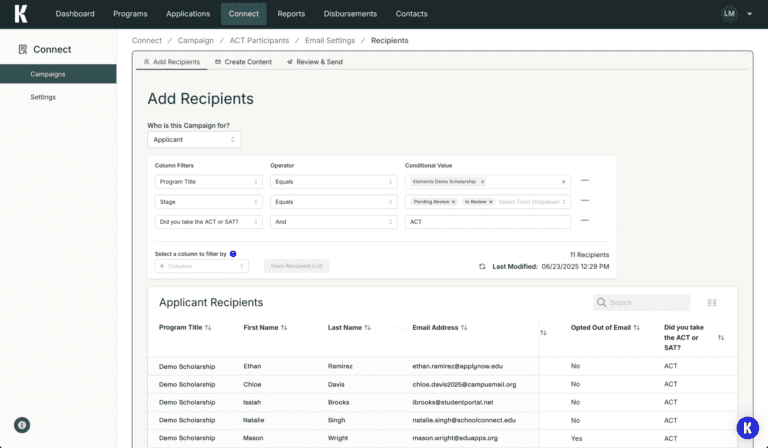Scholar engagement doesn’t stop at “Congratulations, you’ve won!”
In fact, the most successful programs are those that build an ongoing relationship with their recipients, one that drives participation, strengthens your brand, and inspires alumni to give back.
But effective communication is as much about timing and format as it is about content. Here’s how to make every message count.
The Right Message at the Right Time
Students’ lives run on tight schedules. Your messages are more likely to be read and acted on when they arrive at moments that fit into their day.
Email:
Best for: Detailed information, deadlines, and resources that may require rereading.
Timing tips: Mid-morning (9–11 AM) or early evening (6–8 PM) on weekdays works best. Avoid Friday afternoons when inboxes get ignored.
SMS:
Best for: Quick reminders, urgent updates, and deadline nudges.
Timing tips: Early afternoon (1–3 PM) tends to get the fastest replies. Weekends can work for urgent items, but should be used sparingly.
Pro Tip: With Kaleidoscope’s Connect and integrated SMS tools, you can automate reminders based on an applicant’s stage, so the right nudge goes out exactly when they need it.

Channel Fit Matters More Than You Think
Imagine texting a five-paragraph policy update or emailing “Your deadline is in 10 minutes!” to a crowded inbox. Both would likely miss the mark.
Here’s a quick gut check before hitting send:
If the recipient will need to reference it later, email is your friend.
If you need immediate action, SMS wins every time.
If it’s directly tied to the application experience, in-application messaging keeps everything in one place.
Kaleidoscope’s SRM keeps these channels talking to each other so you’re not juggling disconnected tools or wondering who saw what.
Keep Scholars Talking Back
Good communication isn’t just about broadcasting, it’s about building two-way trust.
Instead of only sending updates, give recipients a chance to respond, share wins, or ask for help. This can be as simple as:
A short “How’s it going?” check-in text mid-semester
A poll in your next email asking what resources they need
A quick form for collecting updates and testimonials
When this feedback flows directly into your SRM dashboard, it’s easy to see trends, address challenges, and even collect great stories for donor communications.

Learn From Every Message
You don’t have to guess which messages resonate; the data will tell you.
Glance at Connect or SRM analytics and look for patterns:
Do texts get opened but not replied to?
Are email click-through rates climbing or falling?
Which subject lines or send times get the most traction?
Treat each campaign as a learning opportunity, and your communication plan will get sharper each cycle.
Final Thought
Engaging scholars isn’t about sending more messages; it’s about sending the right ones, in the right way, at the right time. When your SMS, Connect, and SRM tools work in harmony, your outreach becomes more personal, more efficient, and far more impactful.











